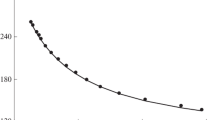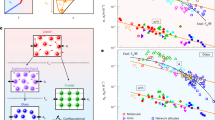Abstract
It has been shown that the currently used method for calculating the temperature range of δT g in the glass transition equation qτ g = δT g as the difference δT g = (T 12–T 13) results in overestimated values, which is explained by the assumption of a constant activation energy of glass transition in deriving the calculation equation (T 12 and T 13 are the temperatures corresponding to the logarithmic viscosity values of logη = 12 and logη = 13). The methods for the evaluation of δT g using the Williams–Landel–Ferry equation and the model of delocalized atoms are considered, the results of which are in satisfactory agreement with the product qτ g (q is the cooling rate of the melt and τ g is the structural relaxation time at the glass transition temperature). The calculation of τ g for inorganic glasses and amorphous organic polymers is proposed.
Similar content being viewed by others
References
S. V. Nemilov, Glass Phys. Chem. 39 (6), 609 (2013).
G. M. Bartenev, Dokl. Akad. Nauk SSSR 76, 227 (1951).
D. S. Sanditov, M. V. Darmaev, and B. D. Sanditov, Phys. Solid State 57 (8), 1666 (2015).
D. S. Sanditov, J. Exp. Theor. Phys. 115 (1), 115 (2012).
MDL®SciGlass-7.8 (Institute of Theoretical Chemistry, Shrewsbury, United Kingdom, 2012).
J. D. Ferry, Viscoelastic Properties of Polymers (Wiley, New York, 1970).
D. S. Sanditov, S. Sh. Sangadiev, and B. D. Sanditov, Glass Phys. Chem. 26 (2), 59 (2000).
V. A. Durov and M. I. Shakhparonov, Zh. Fiz. Khim. 53, 2456 (1979).
D. S. Sanditov, D. B. Dorzhiev, and Zh. P. Baldanov, Zh. Fiz. Khim. 47, 2990 (1973).
G. M. Bartenev and I. A. Luk’yanov, Zh. Fiz. Khim. 29, 2586 (1955).
G. M. Bartenev, Structure and Mechanical Properties of Inorganic Glasses (Stroiizdat, Moscow, 1966) [in Russian].
D. S. Sanditov and G. M. Bartenev, Physical Properties of Disordered Structures (Nauka, Novosibirsk, 1982) [in Russian].
M. V. Vol’kenshtein and O. B. Ptitsyn, Dokl. Akad. Nauk SSSR 103, 795 (1955).
Ya. I. Frenkel’, Introduction of the Theory of Metals (OGIZ, Leningrad, 1948) [in Russian].
M. L. Williams, R. F. Landel, and J. D. Ferry, J. Am. Chem. Soc. 77, 3701 (1955).
B. A. Bestul, Glastech. Ber. 32, 59 (1959).
F. Simon, Z. Anorg. Allg. Chem. 203, 219 (1931).
Author information
Authors and Affiliations
Corresponding author
Additional information
Original Russian Text © D.S. Sanditov, M.V. Darmaev, B.D. Sanditov, 2016, published in Fizika Tverdogo Tela, 2016, Vol. 58, No. 2, pp. 372–376.
Rights and permissions
About this article
Cite this article
Sanditov, D.S., Darmaev, M.V. & Sanditov, B.D. Temperature range of the liquid–glass transition. Phys. Solid State 58, 382–386 (2016). https://doi.org/10.1134/S1063783416020256
Received:
Published:
Issue Date:
DOI: https://doi.org/10.1134/S1063783416020256




